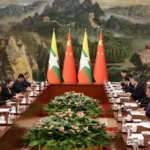
Inle Lake Buddhist Festival in Myanmar: Tradition, Resilience, and Renewal
Introduction
The Inle Lake Buddhist Festival, known locally as the Phaung Daw Oo Pagoda Festival, is one of Myanmar’s most celebrated events. Held each year on the scenic waters of Inle Lake, the festival combines religious devotion, cultural heritage, and vibrant community spirit. Despite recent setbacks caused by natural disasters, political turmoil, and the COVID-19 pandemic, the festival continues to shine as a symbol of resilience.
This year’s celebration highlights not only the beauty of Myanmar’s traditions but also the strength of the Intha people who call Inle Lake home.
A Festival of Devotion and Beauty
At the heart of the celebration is a grand barge covered in gold. Its bow features the image of the mythical Karaweik bird, a design found in Burmese royal architecture. The barge carries four sacred Buddha images from the Phaung Daw Oo Pagoda. Over two weeks, these images travel to 21 lakeside villages, allowing residents to pay homage.
The journey is dramatic. Dozens of smaller wooden boats escort the barge, rowed by Intha fishermen who practice a unique form of leg-rowing. They balance on one leg while wrapping the other around a single oar. This extraordinary technique has become a cultural trademark of Inle Lake and a highlight for visitors from around the world.
The Setting: Inle Lake
Inle Lake lies in southern Shan State, about 260 miles northeast of Yangon. Surrounded by mountains, the lake stretches 13.5 miles long and 7 miles wide. Villages are built on stilts, and floating gardens supply vegetables and flowers.
The region is one of Myanmar’s premier tourist hubs. Before the pandemic, thousands of travelers visited each year to experience the festival, explore floating markets, and admire the lake’s natural beauty.
Interruptions to the Celebration
Although the Buddhist Lake Festival has a centuries-old history, recent years brought severe challenges.
COVID-19 Pandemic (2020): Public health restrictions forced the suspension of the festival.
Political Upheaval (2021): After the military coup, Myanmar fell into civil conflict. Organizers canceled the festival for safety reasons.
Flooding (2022): Heavy rains caused widespread flooding around the lake, preventing the event once again.
Return in 2023: The festival resumed with smaller crowds but renewed devotion.
However, in 2024, tragedy struck again.
Earthquake Devastation in 2024
On March 28, a 7.7 magnitude earthquake shook Myanmar, killing more than 3,800 people nationwide. Inle Lake was not at the epicenter, but the quake still caused major damage.
Houses destroyed: Many stilt houses collapsed into the water. Some villages reported up to 90 percent destruction.
Lives lost: Local estimates suggest between 50 and 90 deaths in the area.
Displacement: More than 13,000 residents were affected, according to E Guard Environmental Services.
The disaster left deep scars. Many families rushed to rebuild homes in the traditional stilt-house style. Yet, skilled craftsmen were scarce, and repairs often lacked structural stability.
Voices from the Lake
Nyi Nyi Zaw, a 42-year-old Intha from Heyarywarma village, described the situation:
“Not all the houses are standing straight. To restore them properly, we will need to wait until the lake dries in the summer.”
He also reflected on years of hardship:
“The tourism industry collapsed after the pandemic. Then came the coup in 2021. After that, floods hit us in 2022. It feels like one misfortune after another.”
Another villager, Ma Win, runs a traditional textile stall. Despite the difficulties, she joined the festival with pride:
“It has been years since the Buddha statues visited our village. We participate as much as we can. The tradition must live on.”
A Festival That Refuses to Fade
Even after loss and hardship, the people of Inle Lake continue the Phaung Daw Oo Pagoda Festival. For them, it is more than a celebration. It is a spiritual duty and a living heritage passed down for generations.
Visitors may notice smaller crowds and fewer decorations compared to the past. Yet, the essence remains intact — faith, unity, and cultural pride. The golden barge still glides across the lake. The leg-rowers still guide it with strength and grace. Families still prepare offerings and prayers.
Why the Festival Matters
The Inle Lake Buddhist Festival plays several roles in Myanmar’s cultural and social fabric:
Religious Significance: Villagers see the visit of Buddha statues as a blessing for health, prosperity, and protection.
Cultural Identity: The Intha people showcase their rowing technique, handicrafts, and traditions.
Tourism Impact: The festival draws both domestic and international visitors, helping the local economy.
Community Resilience: By continuing the event after crises, residents affirm their collective strength.
Looking Ahead
The future of the festival depends on Myanmar’s broader recovery. Stability, economic growth, and disaster preparedness will shape its path. For now, the people of Inle Lake remain determined to keep their traditions alive.
In times of crisis, the festival is more than a tourist attraction. It becomes a symbol of Myanmar’s resilience, faith, and enduring cultural beauty.
Frequently Asked Questions (FAQ)
Q: What is the Inle Lake Buddhist Festival?
A: It is the Phaung Daw Oo Pagoda Festival, a major Buddhist event where sacred Buddha images travel to 21 villages around Inle Lake.
Q: Why is the festival important?
A: It combines religion, culture, and tourism. Locals see it as a blessing, and it showcases Myanmar’s traditions.
Q: What challenges has the festival faced recently?
A: The pandemic, political upheaval, floods, and a devastating earthquake all disrupted the celebration in recent years.
Q: What makes Inle Lake unique?
A: The Intha people’s leg-rowing technique, stilt houses, floating gardens, and mountain scenery make the lake a special cultural site.
Ref: Wikipedia
Related posts:
 Myanmar Junta Revokes Citizenship of Actors, Singers, and Celebrities
Myanmar Junta Revokes Citizenship of Actors, Singers, and Celebrities
 Dozens Killed in Chaung-U as Myanmar Military Launches Paraglider Attack
Dozens Killed in Chaung-U as Myanmar Military Launches Paraglider Attack
 Malaysia Postpones ASEAN Delegation Visit to Myanmar
Malaysia Postpones ASEAN Delegation Visit to Myanmar
 Bishop Peter Tin Wai: Myanmar Civilians Struggle to Survive
Bishop Peter Tin Wai: Myanmar Civilians Struggle to Survive
 China Is Powering Myanmar’s Junta Back to Rule
China Is Powering Myanmar’s Junta Back to Rule
 ADB GRANTS MYANMAR A $100 MILLION SUPPORT PACKAGE.
ADB GRANTS MYANMAR A $100 MILLION SUPPORT PACKAGE.
